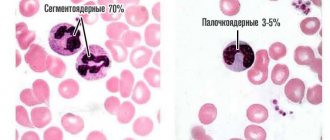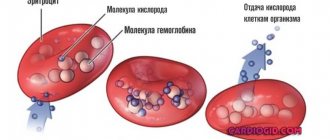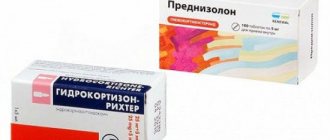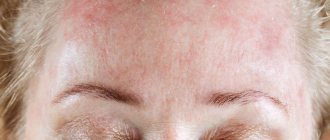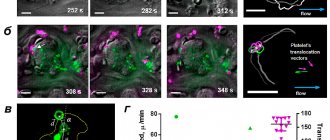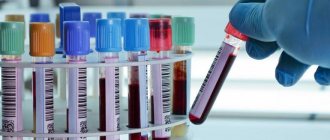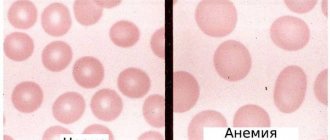Each element of the blood performs its own function in the body, which is why it is so important that their levels remain at optimal levels. Small, anucleate platelets of blood called platelets take part in such an important process as blood clotting. They are responsible for the formation of a blood clot at the site of vessel damage in order to stop bleeding, support the constriction of blood vessels and their nutrition, and participate in immune processes and dissolution of the clot. That is, the rate of blood clotting and wound healing depends on their quantity and quality characteristics.
A condition characterized by low platelet levels is called thrombocytopenia. It can be observed in both adults and children. If, after taking a blood test, it is discovered that the child’s platelets are low, the cause should be determined and treatment should begin.
Classification of thrombocytopenia by severity
There are four degrees of thrombocytopenia in children:
- 75-99X10⁹/l – soft;
- 50-74X10⁹/l – moderate;
- 20-49X10⁹/l – medium weight;
- less than 20X10⁹/l – heavy.
The lower the platelet level, the more severe the symptoms. In mild and moderate forms of manifestation, they may be absent or unexpressed, for example, periodic nosebleeds are observed. As a rule, low platelets at this stage are discovered by chance.
Low platelet levels in children often result in nosebleeds
With moderate thrombocytopenia, hemorrhagic rashes appear on the body. In severe cases, internal hemorrhages and bleeding from the gastrointestinal tract are possible.
A general blood test in pediatrics is a mirror of a child’s health.
Timely and effective treatment of any disease always depends on a correct diagnosis. Any adult, visiting a pediatrician with their child about an illness, wants his child to recover as quickly as possible. On the other hand, it is very important for the attending physician, in addition to complaints, medical history and the objective condition of a small patient, to have data from laboratory and instrumental examinations when making a diagnosis. The most universal of them are general clinical blood and urine tests. Their value lies not only in the speed and ease of implementation, but also in the highly informative content of the results. A general blood test is always taken on an empty stomach (except in emergency cases), i.e. Before coming for the procedure, you must avoid taking any food and limit your fluid intake. Therefore, blood is taken for analysis in the morning so that the child does not have to starve for a long time. The material for analysis is blood taken from a finger or vein. The importance of this rule is due to the fact that after eating, some indicators (the level of white blood cells - leukocytes, ESR) may deviate from the norm, thereby creating a false picture of the disease. If possible, you need to prevent stress when taking blood from a child over 2 years old by talking with him the day before about the upcoming examination, encouraging him after the procedure, etc. Now for you, dear Parents, a little information about the most frequently determined indicators included in the general blood test form.
Hemoglobin is a substance that is part of red blood cells and acts as a carrier of oxygen and carbon dioxide, consists of protein and iron. Normal hemoglobin levels: – newborns – 160-230 g/l; – children under one year old – 110-130 g/l; – from one to 4 years – 110-140 g/l; – from 4 to 7 years – 110-146 g/l; – from 7 years and older – 110-152 g/l. An increase in hemoglobin levels is observed during high physical activity, excitement, stressful situations, dehydration (vomiting, diarrhea), burns and some blood diseases. A decrease in hemoglobin levels is typical for anemia of various origins, degenerative processes, and may be a side effect of certain medications.
Hematocrit is an indicator indicating what part of the blood volume is occupied by formed elements (cells). The norm for newborns is 40-60%, for children from 2 months to 4 years 30-41%, from 4 years and older 34-43%. An increase in the hematocrit level is observed with blood thickening associated with dehydration or diseases that increase the number of cells (erythremia, leukemia). A decrease in this indicator occurs with anemia.
Erythrocytes are red blood cells that contain hemoglobin. Responsible for the transport of oxygen, carbon dioxide, amino acids, antibodies, drugs and toxins. The lifespan of these cells is 120 days. Normal indicators for children: – from birth to 2 months. — 3.9-6.2 T/l; – from 2 to 4 months. — 3.1-4.5 T/l; – from 4 months to 4 years – 3.0-5.4 T/l; – from 5 years and older – 3.5-5.0 T/l. An increase in the level of red blood cells is characteristic of oxygen starvation, chronic lung diseases, congenital heart defects, some blood diseases and neoplasms. A low level of red blood cells is observed with anemia, infections, helminthic infestations, bleeding, obesity, due to increased background radiation. The cause and form of anemia can be determined by the average volume of red blood cells. For children aged 4 months to 4 years, the norm is 75-115 fL, from 5 to 7 years 76-108 fL, from 8 years and older -76-96 fL. An increase in this indicator is observed in anemia associated with deficiency of vitamin B12, folic acid, liver diseases, dysfunction of the bone marrow and thyroid gland, and after bleeding. A decrease in the indicator is characteristic of iron deficiency anemia; hyperfunction of the thyroid gland; anemia associated with chronic diseases; congenital anemias.
Leukocytes are white blood cells whose main function is to protect the body from foreign influences. Leukocytes participate in inflammatory, allergic, and immune reactions, destroying cell breakdown products, viruses and bacteria. Normal indicators: – for newborns – 13-20 G/l; – for children from 1 week to 1 month – 5-20 G/l; – for children from 1 month to 1 year – 6-15 G/l; – from 1 year to 6 years – 5-14 G/l; – from 6 years and older – 6-11 G/l. An increase in the level of white blood cells (leukocytosis) is observed after acute bleeding; for neoplasms; blood diseases; for most infectious diseases of a bacterial nature (both acute and chronic). Short-term physiological leukocytosis is provoked by food intake, pain, emotional stress, physical effort, and exposure to ultraviolet radiation. A decrease in the level of leukocytes (leukopenia) is observed in infections such as influenza, ARVI, measles, psittacosis, viral hepatitis and malaria. Long-term bacterial infections, depleting the body, also reduce the level of leukocytes. Dangerous causes of leukopenia are blood diseases, autoimmune diseases, and the consequences of exposure to radiation.
The leukocyte formula includes a group of cells of different structure and function (neutrophils, eosinophils, basophils, monocytes, lymphocytes), the quantitative determination of which provides a lot of valuable diagnostic information.
Neutrophils are the most numerous type of leukocytes. According to the degree of maturity, young, band and segmented neutrophils are distinguished. The main function of these cells is protective. Normally, the majority of neutrophils should be represented by segmented cells. The appearance of young forms and a large number of band neutrophils in the child’s blood most often indicates an acute inflammatory process. The normal content of neutrophils in the blood of a child from 4 months to 4 years is 30 - 55%, at the age of 5-7 years - 40 - 60%, 8 - 14 years - 45 - 70%. An increased number of neutrophils is observed during inflammatory processes, after surgical interventions, against the background of bacterial, fungal and some viral infections, parasitic infestations, during intoxication, blood diseases, and neoplasms. A low level of neutrophils is characteristic of anemia, acute viral and chronic infections.
Eosinophils are cells that indicate allergic reactions in the body. In children at any age, the norm is from 1 to 5%. An increase in the rate is observed in allergic diseases: bronchial asthma, urticaria, Quincke's edema, hay fever, hypersensitivity to drugs, a number of skin diseases, scarlet fever, helminthic infestations, and some neoplasms.
Basophils are participants in allergic and inflammatory reactions. Normally, the number of basophils ranges from 0 to 5% of the total number of leukocytes. Of clinical significance is the increase in the number of basophils, which is observed in allergic reactions, leukemia, lymphogranulomatosis, and decreased thyroid function. Lymphocytes are the most active cells of the immune system, taking part in all types of its activities. The level of lymphocytes changes significantly throughout a child's life: in children under 5 years of age, the number of lymphocytes normally exceeds the number of neutrophils, and after 5 years the situation changes to the exact opposite. If at the age of up to 5 years the norm is 45 - 65% of lymphocytes, then by 7 years the normal figure decreases to 30 - 55%, and then at 8 years and older to 20 - 40%. An increased number of lymphocytes in the blood is observed in most viral infections: viral hepatitis, infectious mononucleosis, whooping cough, rubella, cytomegalovirus, herpes, as well as tumor diseases. A decrease in the level of lymphocytes is characteristic of bacterial diseases, tuberculosis, systemic lupus erythematosus, renal failure, bone marrow dysfunction, and immunodeficiency conditions.
Monocytes are also immune response cells. The norm for children of any age is up to 8%. An increase in the rate is observed in viral and fungal infections, septic endocarditis, during recovery from infectious diseases, tuberculosis, neoplasms, and rheumatoid arthritis. A low level of monocytes is characteristic of leukemia, severe forms of anemia, and exhaustion of the body.
Erythrocyte sedimentation rate (ESR). The value of this indicator depends on the viscosity of the blood, the presence of normal and pathological proteins in it, and the number of cellular elements. By itself, the ESR value does not mean anything, however, in combination with other changes in the general blood test and the condition of the child, the indicator can provide very useful and necessary information. For children, the normal level of ESR is considered to be 2-10 mm/h (in newborns 1-2 mm/h, in children under 6 years old the rate can be increased to 15 mm/h). An increase in ESR is observed during infections, inflammatory diseases, anemia, tumors, and while taking certain medications. A decrease in ESR is characteristic of some types of anemia and blood diseases.
Platelets are blood platelets. The main function of platelets is to clot blood and stop bleeding. Normal values for children under 7 years of age are 150 - 400 G/l, 8 - 14 years old - 150 - 380 G/l. An increase in platelet levels is observed in cases of blood cancer, tuberculosis, rheumatoid arthritis, anemia, after surgery or physical activity. A decrease in the rate is typical for viral and bacterial infections, chronic bleeding, liver and kidney diseases, severe anemia, diseases of the immune system, tumors, congenital heart defects, and impaired thyroid function.
Dear parents, I would like to draw your attention: the limits of normal blood counts may vary depending on the laboratory that conducted the study. Therefore, always compare the results obtained with the reference values indicated in the analysis form!
The results of a general blood test can only be interpreted in conjunction with all available medical information: taking into account complaints, medical and life history, examination data, and the results of other laboratory and instrumental examinations.
Only an experienced doctor can understand such a volume of information, so be sure to discuss the results of your child’s general blood test with your pediatrician.
Be healthy!
Why is it developing?
There are three main causes of low platelets:
- Decreased formation of anucleate cells in red bone marrow.
- Increased platelet destruction is the most common cause of low platelets.
- An abnormal distribution that results in a decreased concentration of platelets in the bloodstream.
Thrombocytopenia can be an independent disease, but often low platelets in a child are a symptom of various pathologies. The reasons may be as follows:
- infectious bacterial diseases;
- idiopathic thrombocytopenic purpura, in which platelets are destroyed due to autoimmune reactions;
- uremic syndrome;
- anemia;
- blood diseases;
- allergies (most often as a result of long-term use of medications);
- viral infections (mumps, rubella, measles, hepatitis);
- parasitic diseases;
- autoimmune reactions (lupus erythematosus);
- tuberculosis;
- poisoning due to inhalation of heavy metal vapors;
- penetration of antibodies from mother to fetus through the placenta;
- malignant diseases of the blood or bone marrow.
Thrombocytopenia in cancer patients
Thrombocytopenia is a problem that is familiar to many cancer patients. It develops due to chemotherapy: due to the use of platinum drugs (carboplatin, cisplatin, oxaliplatin) and gemcitabine. Each drug has its own mechanism for the development of thrombocytopenia:
- Platinum preparations
. These are alkylating agents that affect stem cells. Because of this, the production of platelets, as well as leukocytes and red blood cells, is suppressed; - Cyclophosphamide
. Affects the formation of megakaryocytes, from which platelets are subsequently formed; - Bortezomib
. Disturbs the process of separation of platelets from megakaryocytes; - Some medications cause platelet death
.
Radiation therapy also causes thrombocytopenia: it impairs bone marrow function, leading to low red blood cell levels. Thrombocytopenia develops especially often after radiation therapy in the pelvic area.
The likelihood of developing thrombocytopenia is even higher when radiation and chemotherapy are administered simultaneously. Certain tumors can also contribute to the development of this disease: lymphoma and leukemia. In this case, cancer cells quickly attack the red bone marrow, replacing its tissue with pathological ones. Less commonly, thrombocytopenia develops with damage to the bones, mammary glands, prostate and spleen.
When the level of platelets in the blood of cancer patients decreases, doctors need to determine the exact causes of this phenomenon. It may be necessary to change the treatment regimen or replace medications. Due to thrombocytopenia, the patient’s well-being significantly worsens, and difficulties arise in the treatment of oncology. Among them:
- When platelets decrease to less than 100*109 per liter
, the risk of bleeding increases; - Less than 50*109 per liter
– surgical interventions are not possible due to the risk of bleeding; - Less than 10*109 per liter
– multiple spontaneous bleeding occurs.
How does it manifest?
With low platelets, the blood becomes liquid, clots poorly, and there is a danger of bleeding not only externally, but also internally. The child often develops bruises, and bruises are not needed to form them - touches are enough. The main symptoms in children are as follows:
- pinpoint rashes are observed in almost 100% of cases;
- about a third have nosebleeds;
- 20% of children have bleeding gums;
- pink or red urine due to blood in it;
- vomiting blood;
- black feces;
- With abrasions and cuts, the bleeding does not stop for a long time.
A characteristic symptom of thrombocytopenic purpura in children is the formation of hemorrhages on the body
Functions and role of platelets
Platelets are small plates that are part of the blood. They prevent the formation of blood clots and protect blood vessels. If the walls of a capillary or vessel are damaged, platelets accumulate around the diseased area and form a clot.
The life cycle of platelets begins from the moment they are separated from the red bone marrow and lasts about 8-10 days. At this time, the blood platelets retain their spherical shape and move freely through the vessels. The destruction of dead cells occurs in the liver and spleen.
Blood clotting depends on the number of platelets in its composition. To eliminate damage to the endothelium, they are deformed, acquiring a star shape. Layering one on top of the other, platelets form a blood clot. The rapid formation of a blood clot is facilitated by coagulation proteins released into the blood.
Platelets perform four main functions in the human body:
- The angiotrophic function ensures tissue integrity. When blood platelets are destroyed or interact, biological substances are produced that serve as food for the walls of blood vessels.
- The hemostatic function is to constrict blood vessels when damage occurs. Platelets accumulate in the resulting holes, thereby forming platelet plugs. This makes it possible to narrow the channel passage to avoid the leakage of biological fluid.
- The phagocytic function allows platelets to fight the development of pathogenic microorganisms. They attach to the walls of bacteria and inhibit their vital activity. Thus, the negative impact of external factors on the body is minimized, and the functioning of the immune system is stabilized.
- The regenerative function promotes the restoration of vascular walls due to growth factors. When the level of platelets decreases, the risk of blood loss increases due to the appearance of internal bleeding, since the strengthening of blood vessels will be insufficient.
Primary thrombocytopenia
Acute thrombocytopenic purpura is an autoimmune disease, the causes of which are unknown. Most often it is observed in children from 2 to 6 years old. It usually occurs after vaccination or a viral infection. The disease develops rapidly, and hemorrhagic manifestations are immediately observed:
- Both pinpoint and larger elements (petechiae and ecchymoses) appear on the skin;
- hemorrhages on the body can have different colors - from purple-violet to greenish;
- new elements appear suddenly;
- there is no specific localization, hemorrhages are located asymmetrically.
The acute phase of the disease is characterized by nosebleeds, as well as bleeding after tooth extraction; in the puberty period in girls - uterine bleeding. In severe cases, bleeding from the gastrointestinal tract is possible, as evidenced by blood in the stool. In some cases, hematuria (the presence of blood in the urine) and hemorrhages in the mucous membranes are observed. Sometimes hemorrhages occur in internal organs, in the retina, and in the brain. Some children have an enlarged spleen.
Treatment options
A treatment regimen can be selected after the cause of the disease has been identified. To quickly normalize the blood cell count, it is necessary to act comprehensively.
Medicines
Taking medications from the following pharmacological categories will help increase platelet production:
- Immunoglobulins. Available in the form of a solution for intravenous administration. The positive effect is achieved due to the fact that the active components of the drug interact and destroy antigens, accelerating platelet production. The dosage and duration of treatment is determined by the attending physician.
- Corticosteroids. They regulate the activity of the adrenal glands using hormones. In turn, the adrenal glands normalize the functioning of the bone marrow, and platelet production is activated.
- Platelet transfusion. It is prescribed in the rarest cases, when the disease is in an advanced stage and the patient’s life is at risk.
Medical nutrition
The most important step in fighting disease is changing your diet. Your child should eat a proper and balanced diet to increase their platelet count. Products that worsen the situation should be excluded:
- products with added carcinogens;
- fast food;
- oranges, tangerines, grapefruits and juices;
- fatty food;
- fried and smoked foods;
- a pineapple.
The child’s diet should include lean meat (beef is best), quail eggs, sea and river fish. As a complement to the main dish, it is better to choose buckwheat, rice, beans with a lot of greens. Drink natural vegetable juices or mineral water instead of tea.
Traditional methods
The best folk remedy for thrombocytopenia is drinking nettle juice. The child should be given a medicine made from nettle juice and milk (in a 1:1 ratio). The drug is taken three times a day 30 minutes before meals.
She speaks positively about the use of sesame oil. To avoid complications, consult your doctor before starting therapy.
Specifics of treatment for newborns
The main task of doctors is to prevent the development of complications. For immunological forms of pathology, the infant is prescribed:
- Feeding with donor milk for the first 3 weeks, then breast milk is allowed (under platelet control);
- intravenous administration of immunoglobulins;
- Introduction of ascorbic acid and rutin.
In severe cases, platelet transfusion is indicated.
How to treat?
Treatment begins after it is determined why thrombocytopenia has developed. If the causes of low platelets are other diseases, appropriate treatment is prescribed, and their levels return to normal.
In case of primary thrombocytopenia, the child is prescribed bed rest; in case of bleeding of the oral mucosa, it is necessary to give chilled food. In the acute form, spontaneous recovery is possible, but the transition of the disease to a chronic form is not excluded.
Depending on the severity of the condition, treatment can last from one to several months. The main methods are as follows:
- intravenous injections of immunoglobulins;
- hormonal therapy using corticosteroids;
- administration of anti-Rhesus serum;
- transfusion of donor platelet mass;
- surgery to remove the spleen.
Role in the body
Despite the fact that more than 65% of people have been tested for these elements at least once in their lives, not everyone knows what their function is in the body. In professional language, platelets are often called thrombocytes, and their main task is to ensure timely blood clotting.
When a capillary is damaged, platelets ensure the formation of a clot, blocking the wound and thereby stopping the bleeding process. The number of these cells determines how quickly blood will stop moving from cuts and scrapes. The platelet level is determined using a complete blood count.
Symptoms
From the first days of life, thrombocytopenia in newborns has symptoms in the form of rashes - ecchymoses, bruises and petechiae. A characteristic symptom is bleeding of the mucous membranes. Cerebral hemorrhages are described, which is more typical of immune thrombocytopenia.
These signs appear asymmetrically and spontaneously. The rash is polymorphic and polychrome.
With transimmune thrombocytopenia in newborns, the symptoms gradually subside because antibodies do not enter the child’s blood.
The clinical picture in newborns depends on the causative agent of the intrauterine infection, as well as on the stage of pregnancy when it occurred.
With Wiskott-Aldrich syndrome, repeated infections, eczema, and splenomegaly occur at a later date.
Classification
According to the classification of the development of the disease by time, the following types of thrombocytopenia in newborns are distinguished:
- intrauterine;
- early manifestation – up to 72 hours from birth;
- late form – after 72 hours.
The causes of intrauterine thrombocytopenia are associated with the following factors:
- alloimmune reaction;
- intrauterine infection - rubella, cytomegalovirus, toxoplasma;
- autoimmune diseases - systemic lupus erythematosus;
- rarely – severe Rh conflict;
- Wiskott-Aldrich syndrome.
The early form of thrombocytopenia in infants occurs due to:
- pathologies of the placenta;
- maternal diabetes mellitus;
- intrauterine growth retardation;
- asphyxia;
- allo- and autoimmune variants;
- more rarely - infections, thrombosis, Kasabach-Merritt syndrome, metabolic disorders.
The late form of manifestations occurs due to:
- neonatal sepsis;
- necrotizing enterocolitis;
- less often - other pathologies described earlier.


